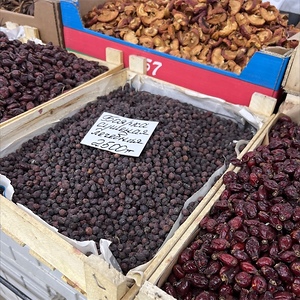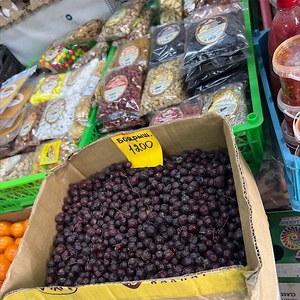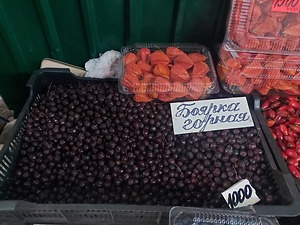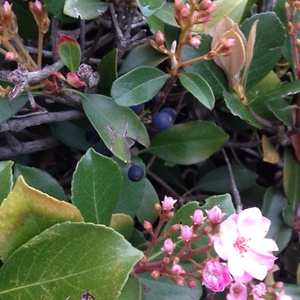


Indian Hawthorn Berries
Estimated Inventory, lb : 0
Description/Taste
Indian Hawthorn Berries are small fruits found on evergreen shrubs. They are similar in size to blueberries, measuring about 0.5 to 1 centimeter in diameter. They display a range of colors from black to blue to purple and have a mostly round, subglobose shape that can sometimes appear slightly oval. The berries feature a smooth outer texture with a slightly chalky residue. Inside, the flesh varies from pale to vivid pinkish-red and is firm and dense, encasing small, inedible seeds. They emit a mild, subtly sweet, and floral scent, reminiscent of the plant's aromatic blossoms. Due to their incredibly tart and astringent flavor, they are typically consumed cooked rather than raw.
Seasons/Availability
Indian Hawthorn Berries are available from late summer to winter.
Current Facts
Indian Hawthorn Berries, botanically known as Rhaphiolepis indica, come from an evergreen shrub in the Rosaceae family. The genus name, Rhaphiolepis, is derived from the Greek words for "needle" and "scale," which refer to the bracts of the flower clusters. The species name, indica, points to its origin in India. There are hundreds of varieties of Indian Hawthorn, including 'Indian Princess', 'Snow White', 'Spring Sonata', and 'Eleanor Tabor'. Some of these plants can live for up to 400 years. While some varieties of Hawthorn may be edible, others could be poisonous, so thorough research is essential before consumption. Although the berries have some culinary uses, Indian Hawthorn is primarily grown for its ornamental value in gardens and is especially admired for its pink and white flowers.
Nutritional Value
While Indian Hawthorn Berries are edible, caution is advised because their seeds aren't safe to eat. These seeds contain amygdalin, a compound that transforms into hydrogen cyanide in the small intestine and can be fatal. Proper removal of the seeds before eating or using them in recipes is thus essential. When prepared properly, Indian Hawthorn Berries can provide pectin, a type of soluble fiber that's also found in fruits like apples, oranges, and berries. Pectin is known for aiding digestive health, managing cholesterol, controlling blood sugar, and supporting heart and gut health. While the Hawthorn Species in general is recognized in traditional Chinese medicine for improving digestion, blood circulation, and treating heart issues, Indian Hawthorn Berries are not widely recognized for their medicinal properties.
Applications
Once the seeds are removed, Indian Hawthorn Berries can be enjoyed raw or cooked. The raw berries may not suit everyone's taste due to their sour and dry flavor that’s reminiscent of an unripe apple. So cooking the berries is often preferred to enhance their flavor. Indian Hawthorn Berries are commonly used in jams and chutneys, especially when mixed with strawberries, blueberries, raspberries, and blackberries. For savory dishes, these berries can be transformed into a sweet and sour ketchup or included in sauces for wild game. They can be used for creating syrups by boiling them with sugar, water, and other berries—ideal for drizzling over ice cream or baked goods. Indian Hawthorn Berries can be infused into spirits, cocktails, or vinegars. Complementary ingredients include citrus zests and juices from lemon, lime, and orange, sweeteners like honey, maple syrup, and agave, as well as almonds, pecans, walnuts, huckleberries, apples, pears, persimmons, shallots, and fatty meats. Spices such as cinnamon, nutmeg, vanilla, and ginger, along with herbs like mint or basil, also pair well. While the fruit, leaves, and stems of the Indian Hawthorn plant are safe to consume, eating large quantities may lead to some intestinal discomfort.
Ethnic/Cultural Info
The Indian Hawthorn plant, known as "teechigi" in Japan, has a long history of use in traditional dyeing techniques. For over four centuries, a dark brown dye has been produced by boiling its dried bark and root, primarily for coloring silk fabrics. In the Amami Islands of Japan, the plant plays a crucial role in the dorozome mud dyeing technique. During this process, branches are cut into chips, simmered for two days, and then filtered to create a golden-orange extract. Yarn is repeatedly dipped and dried in this extract as the color deepens with each immersion. In the Kainan Islands of China, Indian Hawthorn is utilized in the production of textiles and fishing nets. The plant was historically significant in England following the 1845 General Enclosures Act, which allowed hawthorns to be used as hedges to demarcate land. This legislation caused considerable frustration as it restricted the public's ability to freely wander the countryside. It was not until about 150 years later that England introduced the "Right to Roam Act," which restored broader access to such lands.
Geography/History
Indian Hawthorn Berries are native to the warm temperate and subtropical regions of Asia, specifically southern China, Japan, Thailand, Vietnam, and Southern Korea. The plant thrives in sunny climates with well-drained soils and is commonly found on slopes, along streams, and roadside near woodlands, as well as in small gardens. Due to its remarkable ability to adapt to both inland and coastal regions and its high tolerance for salt and drought, Indian Hawthorn has also spread to Australia and various other climates globally. Primarily cultivated for its attractive flowers and overall hardiness, Indian Hawthorn is grown as an ornamental plant in gardens and landscapes, rather than being found in the wild or sold at farmers markets and grocery stores.
Recipe Ideas
Recipes that include Indian Hawthorn Berries. One
| Way of the Wild Heart |
|
Hawthorn Berry Syrup |














